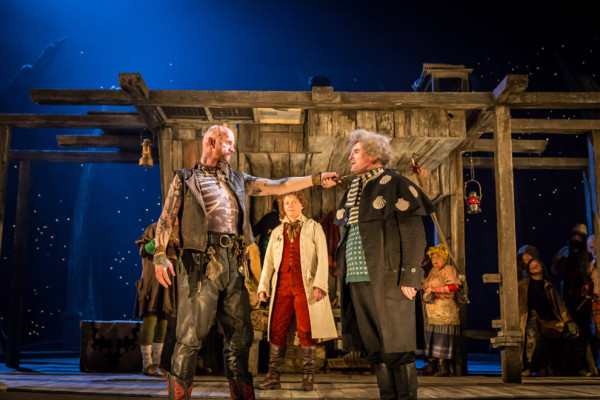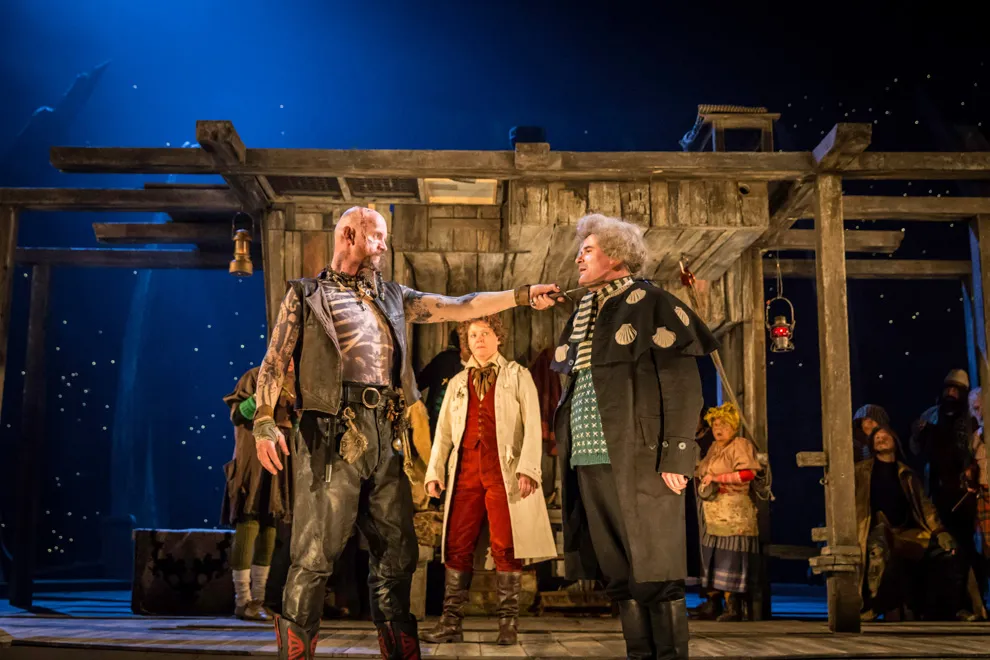
Presenting us with a fresh and exciting interpretation of Robert Louis Stevenson’s classic children’s tale, the National Theatre’s production of “Treasure Island” — as seen in a live broadcast at the Aquarius Theatre in Palo Alto — is dazzling. While nothing can beat the magic of live theater, the spirit of this production is bold enough to transgress the limits of overpriced popcorn and a two-dimensional screen, catapulting its audience into a world of treasure, adventure and non-binary gender identities.
Playwright Bryony Lavery’s spunky new adaptation of Stevenson’s words puts a feminist spin on this timeless coming-of-age story in the representation of our heroine: Jemima “Jim” Hawkins, played by the riveting Patsy Ferran. Here to show us that “girls need adventures too,” Jim, the granddaughter of an innkeeper, is swept up by a ragtag crew of sailors in a quest to find buried treasure. In an effort to play up the humor in this otherwise serious story, the National’s quirky cast appears as a number of comedic supporting characters: Grey, the sailor whom no one can remember (Tim Samuels); Ben Gunn, the castaway with a cheese obsession (Joshua James) and Squire Trelawney, the nobleman who can’t seem to keep his mouth shut (Nick Fletcher), just to name a few. With all the authenticity required for larger-than life personalities, the acting throughout the show consistently blurs the line between the fantasy of Stevenson’s characters and the reality of human folly. Along the way, Jim’s fate intertwines with that of Long John Silver, a fearsome one-legged pirate determined to secure the riches for himself.
The first to play a female rendition of this classic character, Ferran uses her carefully-constructed androgyny — from her gender-neutral appearance to fluctuations in her title from “cabin boy” to “cabin girl” — to capture the best of both masculinity and femininity. She captures the bravado which characterizes the quintessential “pirate narrative” and the gentleness that sets Ferran starkly apart from her brutish co-stars. Many of the more intelligent characters in the play are portrayed in a feminine light. Doctor Livesey (Alexandra Maher), while still identified as a male character, is also played by a woman, and numerous crew members aboard the ship are based on fierce, female pirates who have been engulfed by the male-centric tides of British history.
Even the traditionally hyper-masculine character of Long John Silver is portrayed with a gentle nuance. Played by Arthur Darvill, known best for his role as “Rory” in the BBC series “Doctor Who,” Silver is more of a friend than the father figure he is in Stevenson’s original. Despite his violent past, Darvill plays him with a sweetness and sincerity worthy of the innocent Ferran herself. When Jim is excluded from the “men’s work” in the captain’s loft above, Silver steps in as her only companion in the world. Sitting together on the deck of the mighty Hispaniola, he points to the constellations above, sharing their beauty with Jim and teaching her how to navigate the stars in order to “find [her] way safe through all this evil world.”
Some of the show’s most magical moments come in its design choices. Lizzie Clachan’s spellbinding set functions as both platform and turntable – transforming from the simple inn of Jim’s childhood into a mighty ship, the bubbling sand pits of Treasure Island, a network of underground caves and back again. Under Polly Findlay’s creative direction, actors maneuver in and out of quicksand-ridden trap doors, up and down lofty rigging lines, and through massive sea storms created with booming sound effects and flashing bolts of artificial lightning.
Nearly every moment of the show involves some kind of theatrical ingenuity: The stars which surround Jim throughout the story loom above the entire audience as hundreds of tiny shimmering lights, and the transition from setting to setting is accompanied by authentic folk music, played live by John Tams. Sultry songs describing the might of the seven seas serenade us as a crew of wayward sailors, decked head to toe in regal coats and heinous scars, leads us to fortune and adventure.
Through this creative use of design and fresh re-imagining of a classic boy’s tale, we are invited into a world where we are allowed to believe that regardless of our genders, “we all have a pirate ship in our brain… that takes us somewhere else.”
“Treasure Island” will be playing at the National Theatre in London until April 8.
Contact Madelaine Bixler at [email protected].
